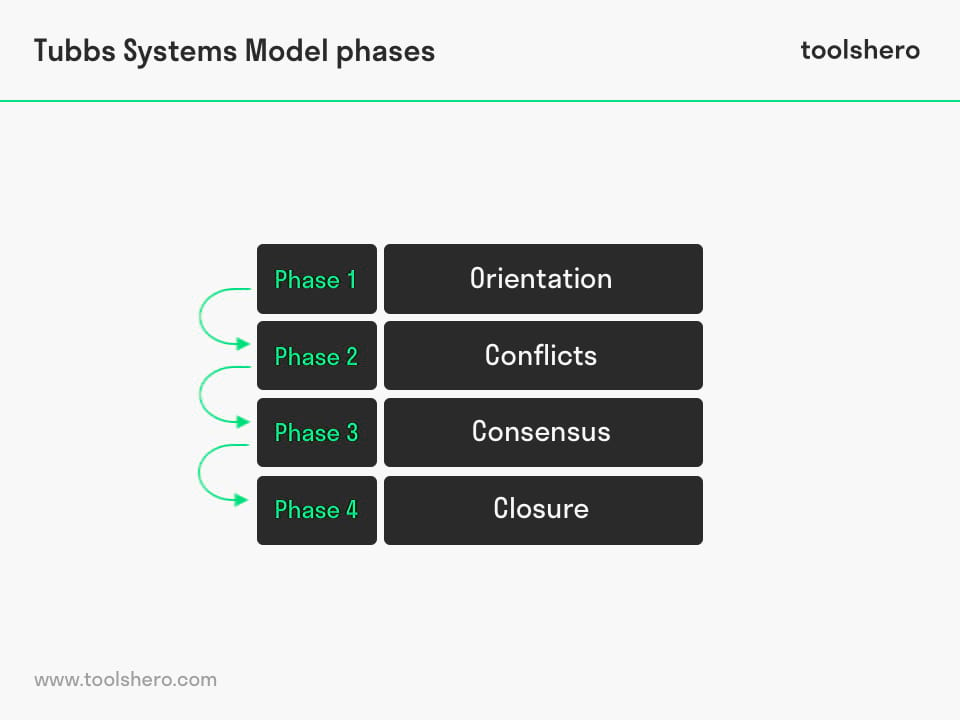Tubbs Systems Model

Tubbs Systems Model: this article provides a practical explanation of the Tubbs Systems Model. After reading, you’ll understand the basics of this powerful management tool.
What is the Tubbs System Model?
The Tubbs System Model is a linear model of group development. Researchers have looked at group development and group dynamics for decades, resulting in various group-related models and theories, such as Tuckman’s model and Kormansi and Mozenter’s group dynamics.
Within this model for group development, Stewart Tubbs approaches group development from a system perspective. In his theory, he builds on Ludwig von Bertalanffy’s somewhat more general system theory of group development. Tubbs suggests Bertalanffy’s model is suitable for analysing group development, but lacks a developmental process.
According to Tubbs, group development is a process that contains three subprocesses. These form the inputs, outputs, and throughputs for a group. Each of these three processes can cause a group to change based on events that occur.
Moreover, the system perspective ensures that the group is capable of learning from setbacks by giving and receiving feedback. Indeed, it’s feedback that binds all the aspects of the model together.
Who developed the Tubbs Systems Model?
The Tubbs Systems Model was proposed by Stewart L. Tubbs. At the time, he was a Darrel H. Cooper Professor of Management at Eastern Michigan University. He received his bachelor’s degree from Bowling Green State University, then began a career at the University of Kansas. Stewart L. Tubbs is the author of various books, including some on human communication and group development.
Tubbs Systems Model: Phases within group development
Studying interaction within small groups led Tubbs to creating a four-phase model for group development: the Tubbs System Model. The model consists of the following four phases.
Phase 1: Orientation
In the first phase, the various group members get to know each other. Together, they begin talking about the problem or project, begin to discuss problems, and research common limitations, opportunities, strengths and weaknesses related to the project or the joint task.
When comparing this model to other models of group development, it becomes apparent that some of the features from this phase are similar to features from the formation phase. In the formation phase, the group has just gotten together, and a feeling of anxiety and insecurity often dominates.
In the beginning, the group members are often discrete, which results from the desire to be accepted by everyone in the group. Wherever possible, conflicts, misunderstandings, personal opinions, and controversies are avoided.
However, the members begin to form impressions of each other and the project, and slowly but surely an image arises of what the group will be doing together.
Consequences of the orientation phase
Typical outcomes of this phase of the Tubbs Systems Model include gaining insight into the project group’s goal, deciding how the team should be organised and who should be responsible for what.
Important project milestones are discussed, and general group rules are formulated as well.
Phase 2: Conflicts
In the second phase, the group’s problem or task is analysed and each group member tries to find a solution by utilising his or her perspective. This leads to increased individual participation in the group.
If the work is considered too much from an individual’s perspective, this can lead a too high level of individuality. This can lead to conflicts. Conflicts are a necessary and inevitable part of the development of the group as a whole. Conflicts allow the group to evaluate ideas, as well as help the group to prevent groupthink and conformity.
In comparable theories, this phase corresponds to the storm phase. Here, strife and competition are at their highest because group members have an understanding of the work and are working on a general sense of connectedness with the group and the group members.
The dominant group members will step into the foreground more and more often, while the less dominant members will remain in their comfort zones.
Consequences of the conflict phase
In this phase, important answers are found to questions related to leadership, authority, rules, and policy within a group.
Responsibilities too are extensively discussed in this phase, however, just as structure, evaluation criteria, and reward systems. These things need to be clear before the step to the next phase can be taken.
Phase 3: Consensus
Once conflicts have been resolved, the group enters the consensus phase of the Tubbs Systems Model. This is where group members compromise, select ideas, and come to agree about possible alternative solutions to problems found. They do so based on the input of each group member.
Working in this phase is more pleasant than in the first phases of group development. Interaction between members becomes lighter, simpler, more cooperative, and more productive.
A feeling of connectedness and mutual respect abounds, and communication between group members and the project manager is open and honest. Nevertheless, a conflict or dispute may still arise, but it will be solved in time, without the group’s work running into a delay or a loss of quality.
Outcomes of the consensus phase
During this phase, members develop most on an individual level. Group members become more flexible, interdependent, and come to trust each other completely.
Leadership is distributive, which means different people can take the lead under different circumstances. Members are also willing to adjust their own behaviour or work to the needs of the group as a whole.
Phase 4: Closure
During the last phase, the closure phase, the end result is announced and the group members confirm their support for the decision. This phase may be confusing and is usually reached when the project has been successfully completed.
At the end of this stage, the project is finished, and project members will depart in various directions for new projects.
Developing successful teams and staying successful
The composition of a group may vary. Different people with different personalities complement each other, but will also often have differences of opinion. That’s why it’s very important to maintain a healthy group dynamic. Paying attention to a number of things within a team will help keep the mood and performance high.
1. Objectives and Feedback
There is an important relation between the way team members function and work together and the quality of the work produced by the group.
Because cooperation is essential to meeting common goals, the members should pay attention to the way they interact and cooperate.
For this it helps to use periodical self-evaluations, and for the team to measure its own effectiveness and to take steps to improve performance.
Group evaluation
Self-evaluation is not always easy and requires an honest, transparent way of communication.
Group members should actively search for both strengths and weaknesses, and use the feedback to build bridges between what should effectively be done and where the team currently is.
Once these areas of improvement have been identified, group members will be able to develop a plan for themselves and for each other in which the performance gap can be closed.
External involvement
The input for this self-reflection can be obtained by regularly organising meetings in which group members discuss what went well and what they want to change for the future. Here, it may be useful to involve someone from outside the group in the meetings, such as a supervisor or a human resources employee.
These people can provide advice based on, for example, a short written survey. Its results can be used as input for discussions and future evaluations.
Communication & personalities
The description of the second phase of the Tubbs Systems Model shows that conflicts are not necessarily negative for the group’s performance. On the contrary, conflicts may lead to an improvement in performance when they are dealt with properly.
However, this is not always the case. Poor communication and conflicts can also disrupt a team’s performance, and personal conflicts between group members may arise.
Different personality traits, such as introversion and extraversion, say a lot about the way people work and communicate. Having people take a diagnostic personality test can provide insight into these preferences and may facilitate mutual acceptance.
2. Responsibility
By responsibility in relation to group development and dynamics, we mean acknowledging and taking responsibility for actions, decisions, and products.
Within a business context, responsibility refers to who is explicitly responsible for ensuring that the expected results and objectives are achieved, and stimulates the success of the group as a whole.
Collective output
Within a team, responsibility means each group member takes responsibility for the group’s collective output and for achieving collective success.
The results of the group as a whole equal the sum of each team member’s individual efforts. Organisations often use rewards based on group results in order to keep individual members motivated and to stimulate responsibility.
Means to success
In order to effectively take responsibility for the work to be done, teams do need to have access to the right skills, resources, and authority.
That’s why leaders need to ensure that success is within reach of the team. For this reason, the above points and the composition of the team have a direct effect on the degree of responsibility that a team can be assigned for its performance.
3. Group size and group members
What’s not immediately apparent from the theory behind the Tubbs Systems Model is that team size, and especially the composition of teams, influence team processes and results.
The optimal size and composition depends on the range of objectives assigned to the team. With too few team members, the team will lack means in terms of time and skill.
Too many members may complicate coordination and communication, which may lead to conflicts and, eventually, poor performance.
Optimal size
In Dr. Meredith Belbin‘s research, it was found that the optimal team size consists of eight roles, plus a specialist if needed.
Fewer than five members results in a lack of different perspectives, while more than twelve members results in an increase in conflicts, as well as a higher chance of subgroups that could disrupt group cohesion.
Diversity
The same research also showed that the mix of knowledge and expertise is important within a team. Individuals are selected based on individual qualities, such that the team has access to all the expertise and skill it needs to achieve its assigned objectives.
4. Team building and development
Team building refers to a wide range of activities intended to help a team become an effective unit. That’s why team building is meant to increase team members’ awareness and understanding of each other by concentrating on each other in a personal sense.
The goal is to form a coherent group that is attuned to one another. Things that could undermine the team and its effectiveness, such as individual and common pitfalls, are avoided. Examples include conflicts, miscommunication, and a lack of trust.
Participation in team building
All members should participate in team-building activities. Such activities are organised especially during the first phase of the Tubbs Systems Model.
It usually starts with an introduction round at the start of the project or task. In that way, members can get to know each other at a calm pace. Sometimes, organisations and teams will use more intensive and time-consuming activities such as an excursion, simulations, personality evaluations, and games in which the group dynamic is tested.
Some companies direct team building from their internal HR policy, whereas others hire consultants that are skilled at facilitating these activities.
Training sessions
Teams may also benefit from team-building activities when they have been working together from quite some time. Sometimes, for example, it becomes apparent after evaluation moments that members lack certain skills that would make cooperation easier.
These could be problem-solving, conflict-solving, or other skills. Training sessions aimed at tackling these shortcomings can improve the team’s ability to cooperate. There are also factors that could hinder cooperation.
These factors arise after people have been working together for some time. For example, different personality types and reactions to feedback can cause a team member to be afraid to point the group leader’s mistakes or working habits out to them.
A discussion between team members offers the opportunity to deal with these factors. It is important, however, to maintain an open and honest communication style.
Now it’s your turn
What do you think? Do you recognise the explanation about the Tubbs Systems Model? What other theories about group development and dynamics do you know? What are your experiences with working within various teams? Could you apply the information and tips from this article in practice? Do you have any questions or additional comments?
Share your experience and knowledge in the comments box below.
More information
- Bion, W. R. (1952). Group dynamics: A re-view. International Journal of Psycho-Analysis, 33, 235-247.
- Cartwright, D., & Zander, A. (1968). Group dynamics.
- Levi, D. (2015). Group dynamics for teams. Sage Publications.
- Tubbs, S. L. (2012). A systems approach to small group interaction.
How to cite this article:
Janse, B. (2020). Tubbs Systems Model. Retrieved [insert date] from Toolshero: https://www.toolshero.com/management/tubbs-systems-model/
Published on: 03/02/2020 | Last update: 05/20/2022
Add a link to this page on your website:
<a href=”https://www.toolshero.com/management/tubbs-systems-model/”>Toolshero: Tubbs Systems Model</a>













